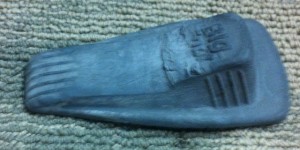Design Problem Debugging Rule #001: Turn it Upside Down
I’m not expecting this topic to be as frequently covered as my Innovation Inspiration (I²) series, because I have found far fewer good techniques.
However, this trick is so fundamental—yet often overlooked—that it deserves the honor of entry #1.
It also applies to many more things than just design problems.
 I was reminded of this rule the other day while trying to prop the office door open. The rubber wedge door stop had seen better days, and even when new, might not have had enough traction on the bottom to keep from sliding across the carpet.
I was reminded of this rule the other day while trying to prop the office door open. The rubber wedge door stop had seen better days, and even when new, might not have had enough traction on the bottom to keep from sliding across the carpet.
I have gotten out of the habit of having a Swiss Army Knife on my belt, or I would have used my standard solution for this problem—extending the corkscrew then setting the tool down in front of the door with the corkscrew’s mount on top facing the door and its tip hooked down in the carpet, so that when the door tries to close, it walks up the corkscrew wedging it deeper into the carpet.
So I was left to improvise, and before I even took one step to start looking for other instruments, I remembered the upside-down rule.
 This simple trick was all it took. The severe wear of the doorstop, from years of people shoving it under the door further and harder, combined with the stresses being applied in directions the designer had not intended, just about broke its back. However, this allowed it to deform enough to route the forces to all the right places needed to stay put.
This simple trick was all it took. The severe wear of the doorstop, from years of people shoving it under the door further and harder, combined with the stresses being applied in directions the designer had not intended, just about broke its back. However, this allowed it to deform enough to route the forces to all the right places needed to stay put.
I first heard of this trick from one of my heroes, who has described it occasionally during his many years on talk radio. The first one I remember was during the design of the first steerable downhole drill bit. It had been tried before, and used with limited success, and he thought he could do better. But what worked fine near the surface clogged and froze when facing higher pressures and temperatures deeper down.
After much frustration, he flipped the design 180° to discover that orientation of the valves overcame the lock-up problems. Although not the first steerable drillbit, his was the first that worked well enough to find widespread use.
I’ve seen many other examples like this, and it’s amazing how often it works. As a result, it’s become the first problem-solving technique I use when I’m stuck.
In fact, I am coming to believe that it is so fundamental that it should be used even when something is working, with the goal being to discover new failure modes and perhaps a bit of genius that is patentable.

